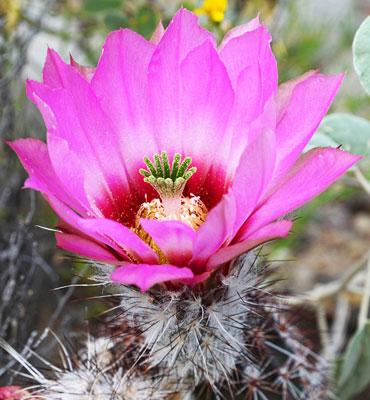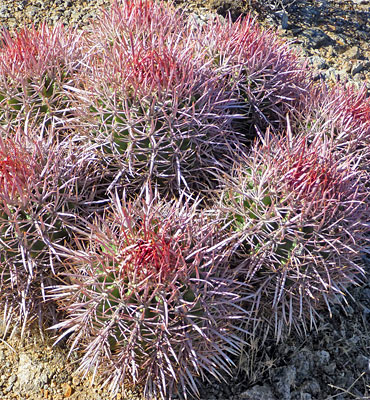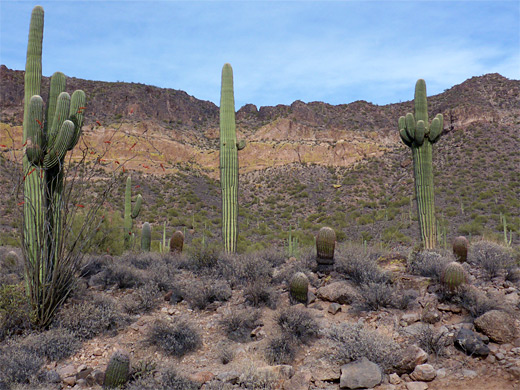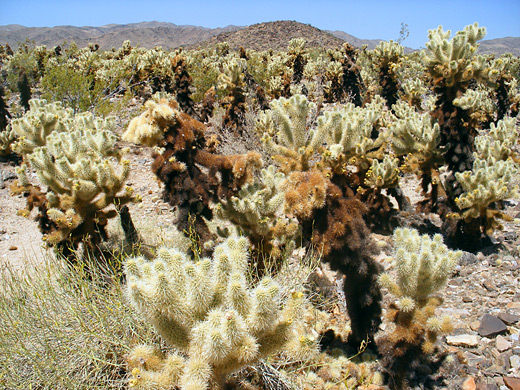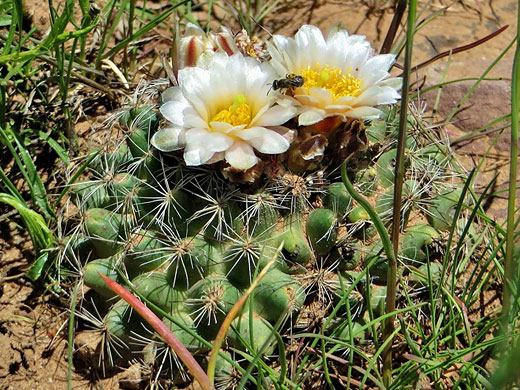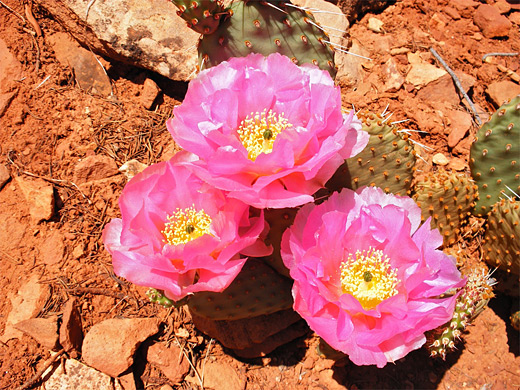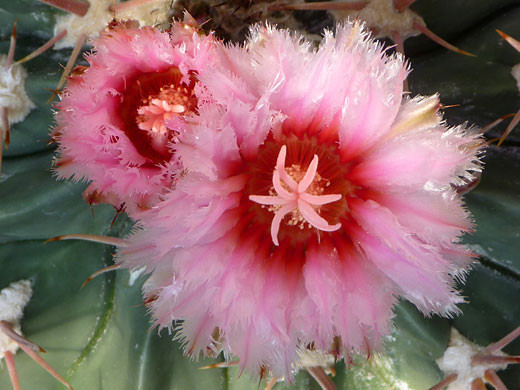Cacti are found in virtually every US state and the southern Canadian provinces, mostly just a few hardy species of opuntia and escobaria, but they are much more widespread in the desert regions of the southwest. There are six states where cacti are abundant, namely (with the approximate number of US species): Arizona (83), California (35), New Mexico (56), Nevada (26), Utah (34) and Texas (91).
The densest colonies are generally found at the lower elevations and most southerly locations, corresponding to the Sonoran, Chihuahuan and Mojave deserts. Of these three, the Mojave has rather fewer species, owing to its low rainfall, and the hottest part of the Sonoran Desert in southeast California and southwest Arizona also has a relatively small number for the same reason: the best places of all to see cacti are south and southeast Arizona, south New Mexico, and far west Texas, especially in the Big Bend region.
Table of Contents
The densest colonies are generally found at the lower elevations and most southerly locations, corresponding to the Sonoran, Chihuahuan and Mojave deserts. Of these three, the Mojave has rather fewer species, owing to its low rainfall, and the hottest part of the Sonoran Desert in southeast California and southwest Arizona also has a relatively small number for the same reason: the best places of all to see cacti are south and southeast Arizona, south New Mexico, and far west Texas, especially in the Big Bend region.
Table of Contents
- Cacti in Arizona
- Cacti in California
- Cacti in Nevada
- Cacti in New Mexico
- Cacti in Utah
- Cacti in Texas
Arizona contains two NPS units dedicated to specific cacti - Saguaro National Park either side of Tucson, and Organ Pipe Cactus National Monument in the far south, bordering Mexico. This latter is one of the best cactus locations anywhere in the state with nearly 30 species, some (for example senita) quite rare. Other desert preserves with many cacti include Kofa NWR, Sonoran Desert National Monument, Cabeza Prieta NWR, Ironwood Forest National Monument and Agua Fria National Monument, and there are several small state parks that offer a good introduction to the flora of this region such as Catalina, Sabino Canyon, Lost Dutchman, Tucson Mountain and Alamo Lake.
Besides Organ Pipe NM, the area with the largest number of uncommon species is in the far southeast between Nogales and the Chiricahua Mountains, were some plants from the nearby Chihuahuan Desert may be seen, plus some that are much more common over the border in Mexico. But cacti grow in good numbers all across the state, with, for example 12 varieties in Canyon De Chelly National Monument, and a few locations in the north are home to very rare species such as pediocactus bradyii in the Marble Canyon area and sclerocactus sileri on the Kaibab Plateau. A good way to see many plant species in one place is to visit a botanical garden, such as Boyce Thompson Arboretum near Superior or Arizona-Sonora Desert Museum west of Tucson.
Besides Organ Pipe NM, the area with the largest number of uncommon species is in the far southeast between Nogales and the Chiricahua Mountains, were some plants from the nearby Chihuahuan Desert may be seen, plus some that are much more common over the border in Mexico. But cacti grow in good numbers all across the state, with, for example 12 varieties in Canyon De Chelly National Monument, and a few locations in the north are home to very rare species such as pediocactus bradyii in the Marble Canyon area and sclerocactus sileri on the Kaibab Plateau. A good way to see many plant species in one place is to visit a botanical garden, such as Boyce Thompson Arboretum near Superior or Arizona-Sonora Desert Museum west of Tucson.
In California, a small number of cactus species found nowhere else in America grow in the far southwest, around San Diego and along the coast towards Santa Barbara, such as the golden cereus, Munz's cholla, coastal cholla, chaparral prickly pear and San Diego barrel cactus. These are viewable in such places as Torrey Pines State Reserve, Santa Monica Mountains National Recreation Area and Cabrillo National Monument, but most California species are found in the deserts of the southeast, where the major parks are Mojave, Anza Borrego, Death Valley, and Joshua Tree, this latter an especially fruitful location since it lies on the border of two distinct desert regions (Sonoran and Mojave), so has plants representative of both.
Cacti are most common in Nevada in the far south, at the edge of the Mojave Desert, where around 20 types grow, seen for example in the hills bordering Lake Mead and Lake Mohave, on the foothills of Mount Charleston and in Red Rock Canyon National Conservation Area. Most visible species include California barrel cactus, many headed barrel, Engelmann's hedgehog cactus, five types of cholla and several opuntia. The remainder of the state is part of the Great Basin Desert and has fewer cacti, though still with a small number of very rare species (sclerocactus).
The southern third of New Mexico is part of the Chihuahuan Desert, and over 50 cactus species may be found here, in such locations as Oliver Lee Memorial State Park, the backcountry of Carlsbad Caverns National Park, and (in a botanical garden setting) Living Desert State Park in Carlsbad.
Cacti of Utah are distributed across most of the state - not just in the low elevation regions of the southwest (at the edge of the Mojave Desert), but all across the Colorado Plateau and around the Uinta Basin of the northeast. There is no single best location, but the famous national parks (Arches, Capital Reef, Zion, Canyonlands) are each home to over a dozen species, and Utah has around six types of cactus not found anywhere else in the US (sclerocactus and pediocactus species).
Texas leads the way in terms of number of different cactus species, with nearly 100, the majority close to the Mexican border along the Rio Grande, especially in the Big Bend region, in Big Bend National Park and Big Bend Ranch State Park. This land is at the northernmost limit of many varieties native to Mexico, and in particular species of coryphantha, echinomastus and escobaria. Another concentration of rare species is found in a far south, around Brownsville. Other Chihuahuan Desert locations good for cacti include Davis Mountains/Fort Davis, Guadalupe Mountains and Black Gap WMA.
Guide to all Southwest cactus species.
View all photographs of cacti.
Guide to all Southwest cactus species.
View all photographs of cacti.
All Contents © Copyright The American Southwest | Comments and Questions | Contribute | Affiliate Marketing Disclosure | Site Map
